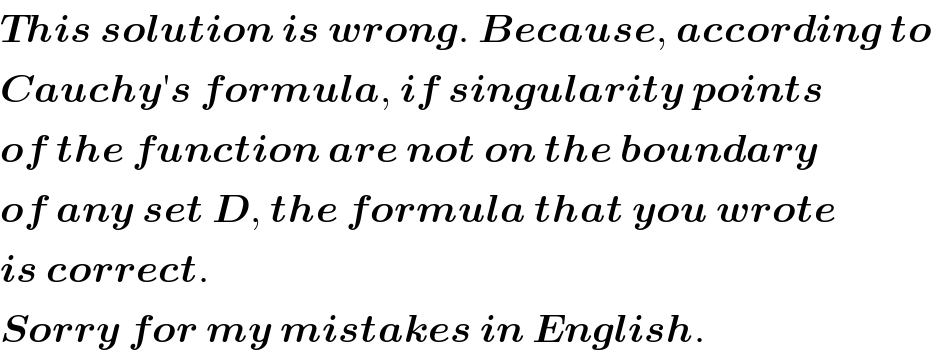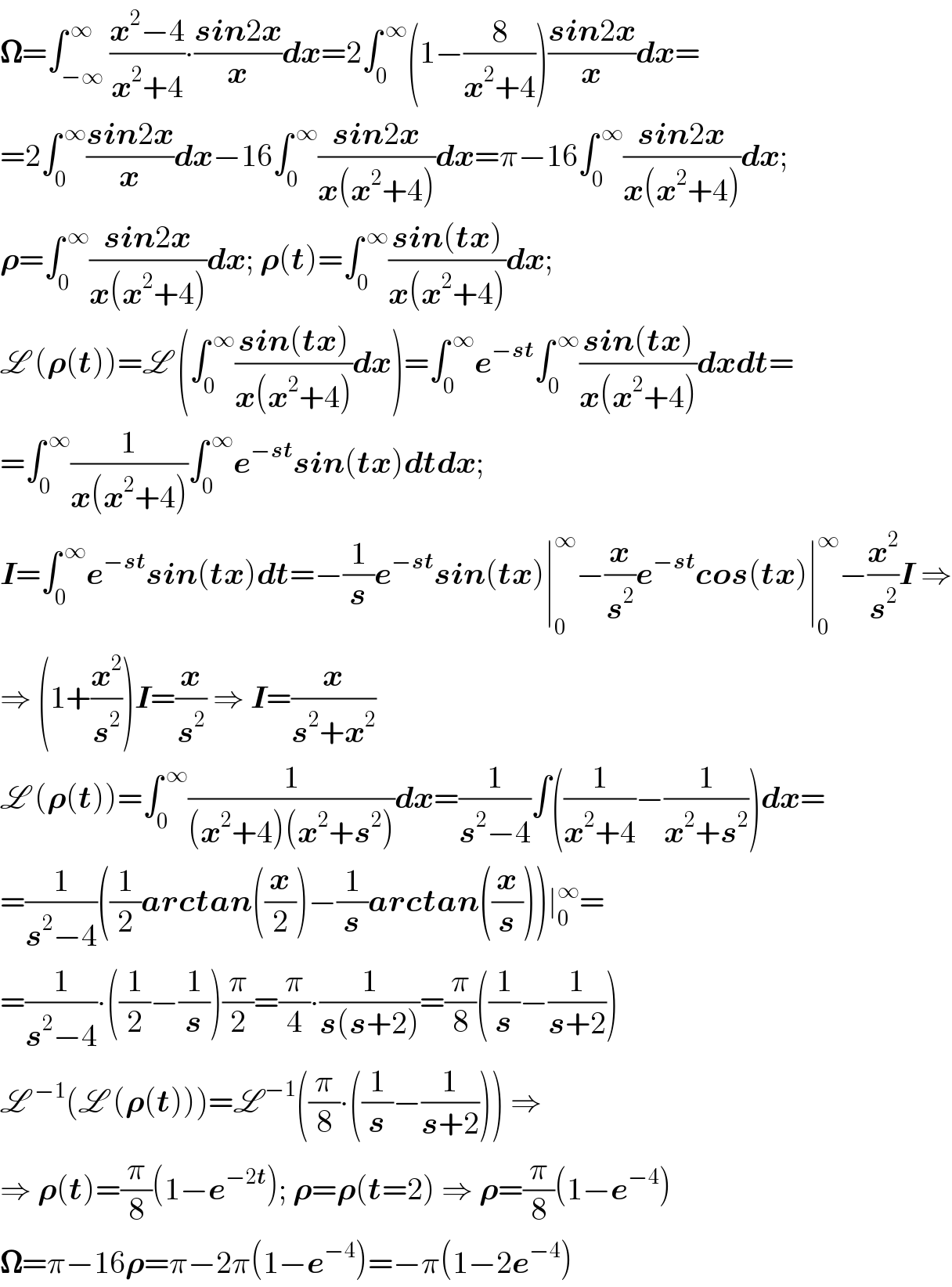Question Number 117121 by mnjuly1970 last updated on 09/Oct/20

$$\:\:\:\:\:\:\:\:…{nice}\:\:{mathematics}.. \\ $$$$ \\ $$$$\:\:{please}\:\:{evaluate}… \\ $$$$\: \\ $$$$\:\Omega\:=\int_{−\infty} ^{\:+\infty} \left(\frac{{x}^{\mathrm{2}} −\mathrm{4}}{{x}^{\mathrm{2}} +\mathrm{4}}\ast\:\frac{{sin}\left(\mathrm{2}{x}\right)}{{x}}\right)\:{dx}\:=???\:\: \\ $$$$\:{m}.{n}.\mathrm{1970} \\ $$$$ \\ $$
Answered by Bird last updated on 10/Oct/20

$${I}\:=\int_{−\infty} ^{+\infty} \:\frac{\left({x}^{\mathrm{2}} −\mathrm{4}\right){sin}\left(\mathrm{2}{x}\right)}{{x}\left({x}^{\mathrm{2}} +\mathrm{4}\right)}{dx}\:\Rightarrow \\ $$$${I}={Im}\left(\int_{−\infty} ^{+\infty} \:\frac{\left({x}^{\mathrm{2}} −\mathrm{4}\right){e}^{\mathrm{2}{ix}} }{{x}\left({x}^{\mathrm{2}} +\mathrm{4}\right)}\:{dx}\right) \\ $$$${let}\:{consider}\:{the}\:{complex}\:{function} \\ $$$$\varphi\left({z}\right)\:=\frac{\left({z}^{\mathrm{2}} −\mathrm{4}\right){e}^{\mathrm{2}{iz}} }{{z}\left({z}^{\mathrm{2}} +\mathrm{4}\right)}\:\Rightarrow \\ $$$$\varphi\left({z}\right)\:=\frac{\left({z}^{\mathrm{2}} −\mathrm{4}\right){e}^{\mathrm{2}{iz}} }{{z}\left({z}−\mathrm{2}{i}\right)\left({z}+\mathrm{2}{i}\right)}\:{residus} \\ $$$${theorem}\:{give} \\ $$$$\int_{−\infty} ^{+\infty} \:\varphi\left({z}\right){dz}\:=\mathrm{2}{i}\pi\left\{\:{Res}\left(\varphi,{o}\right)+{Res}\left(\varphi,\mathrm{2}{i}\right)\right\} \\ $$$${Res}\left(\varphi,{o}\right)\:={lim}_{{z}\rightarrow\mathrm{0}} \:{z}\varphi\left({z}\right) \\ $$$$={lim}_{{z}\rightarrow\mathrm{0}} \:\:\:\frac{−\mathrm{4}}{\mathrm{4}}=−\mathrm{1} \\ $$$${Res}\left(\varphi,\mathrm{2}{i}\right)\:={lim}_{{z}\rightarrow\mathrm{2}{i}} \left({z}−\mathrm{2}{i}\right)\varphi\left({z}\right) \\ $$$$={lim}_{{z}\rightarrow\mathrm{2}{i}} \:\:\:\frac{\left({z}^{\mathrm{2}} −\mathrm{4}\right){e}^{\mathrm{2}{iz}} }{{z}\left({z}+\mathrm{2}{i}\right)}\:\:\: \\ $$$$=\frac{−\mathrm{8}\:{e}^{−\mathrm{4}} }{\left(\mathrm{2}{i}\right)\left(\mathrm{4}{i}\right)}\:={e}^{−\mathrm{4}} \:\Rightarrow \\ $$$$\int_{−\infty} ^{+\infty} \varphi\left({z}\right){dz}\:=\mathrm{2}{i}\pi\left\{−\mathrm{1}\:+{e}^{−\mathrm{4}} \right\}\:\Rightarrow \\ $$$${I}\:=\mathrm{2}\pi\left\{{e}^{−\mathrm{4}} −\mathrm{1}\right\} \\ $$
Commented by AbduraufKodiriy last updated on 10/Oct/20

$$\boldsymbol{{This}}\:\boldsymbol{{solution}}\:\boldsymbol{{is}}\:\boldsymbol{{wrong}}.\:\boldsymbol{{Because}},\:\boldsymbol{{according}}\:\boldsymbol{{to}} \\ $$$$\boldsymbol{{Cauchy}}'\boldsymbol{{s}}\:\boldsymbol{{formula}},\:\boldsymbol{{if}}\:\boldsymbol{{singularity}}\:\boldsymbol{{points}} \\ $$$$\boldsymbol{{of}}\:\boldsymbol{{the}}\:\boldsymbol{{function}}\:\boldsymbol{{are}}\:\boldsymbol{{not}}\:\boldsymbol{{on}}\:\boldsymbol{{the}}\:\boldsymbol{{boundary}} \\ $$$$\boldsymbol{{of}}\:\boldsymbol{{any}}\:\boldsymbol{{set}}\:\boldsymbol{{D}},\:\boldsymbol{{the}}\:\boldsymbol{{formula}}\:\boldsymbol{{that}}\:\boldsymbol{{you}}\:\boldsymbol{{wrote}} \\ $$$$\boldsymbol{{is}}\:\boldsymbol{{correct}}. \\ $$$$\boldsymbol{{Sorry}}\:\boldsymbol{{for}}\:\boldsymbol{{my}}\:\boldsymbol{{mistakes}}\:\boldsymbol{{in}}\:\boldsymbol{{English}}. \\ $$
Answered by AbduraufKodiriy last updated on 09/Oct/20

$$\boldsymbol{\Omega}=\int_{−\infty} ^{\:\infty} \frac{\boldsymbol{{x}}^{\mathrm{2}} −\mathrm{4}}{\boldsymbol{{x}}^{\mathrm{2}} +\mathrm{4}}\centerdot\frac{\boldsymbol{{sin}}\mathrm{2}\boldsymbol{{x}}}{\boldsymbol{{x}}}\boldsymbol{{dx}}=\mathrm{2}\int_{\mathrm{0}} ^{\:\infty} \left(\mathrm{1}−\frac{\mathrm{8}}{\boldsymbol{{x}}^{\mathrm{2}} +\mathrm{4}}\right)\frac{\boldsymbol{{sin}}\mathrm{2}\boldsymbol{{x}}}{\boldsymbol{{x}}}\boldsymbol{{dx}}= \\ $$$$=\mathrm{2}\int_{\mathrm{0}} ^{\:\infty} \frac{\boldsymbol{{sin}}\mathrm{2}\boldsymbol{{x}}}{\boldsymbol{{x}}}\boldsymbol{{dx}}−\mathrm{16}\int_{\mathrm{0}} ^{\:\infty} \frac{\boldsymbol{{sin}}\mathrm{2}\boldsymbol{{x}}}{\boldsymbol{{x}}\left(\boldsymbol{{x}}^{\mathrm{2}} +\mathrm{4}\right)}\boldsymbol{{dx}}=\pi−\mathrm{16}\int_{\mathrm{0}} ^{\:\infty} \frac{\boldsymbol{{sin}}\mathrm{2}\boldsymbol{{x}}}{\boldsymbol{{x}}\left(\boldsymbol{{x}}^{\mathrm{2}} +\mathrm{4}\right)}\boldsymbol{{dx}}; \\ $$$$\boldsymbol{\rho}=\int_{\mathrm{0}} ^{\:\infty} \frac{\boldsymbol{{sin}}\mathrm{2}\boldsymbol{{x}}}{\boldsymbol{{x}}\left(\boldsymbol{{x}}^{\mathrm{2}} +\mathrm{4}\right)}\boldsymbol{{dx}};\:\boldsymbol{\rho}\left(\boldsymbol{{t}}\right)=\int_{\mathrm{0}} ^{\:\infty} \frac{\boldsymbol{{sin}}\left(\boldsymbol{{tx}}\right)}{\boldsymbol{{x}}\left(\boldsymbol{{x}}^{\mathrm{2}} +\mathrm{4}\right)}\boldsymbol{{dx}}; \\ $$$$\mathscr{L}\:\left(\boldsymbol{\rho}\left(\boldsymbol{{t}}\right)\right)=\mathscr{L}\:\left(\int_{\mathrm{0}} ^{\:\infty} \frac{\boldsymbol{{sin}}\left(\boldsymbol{{tx}}\right)}{\boldsymbol{{x}}\left(\boldsymbol{{x}}^{\mathrm{2}} +\mathrm{4}\right)}\boldsymbol{{dx}}\right)=\int_{\mathrm{0}} ^{\:\infty} \boldsymbol{{e}}^{−\boldsymbol{{st}}} \int_{\mathrm{0}} ^{\:\infty} \frac{\boldsymbol{{sin}}\left(\boldsymbol{{tx}}\right)}{\boldsymbol{{x}}\left(\boldsymbol{{x}}^{\mathrm{2}} +\mathrm{4}\right)}\boldsymbol{{dxdt}}= \\ $$$$=\int_{\mathrm{0}} ^{\:\infty} \frac{\mathrm{1}}{\boldsymbol{{x}}\left(\boldsymbol{{x}}^{\mathrm{2}} +\mathrm{4}\right)}\int_{\mathrm{0}} ^{\:\infty} \boldsymbol{{e}}^{−\boldsymbol{{st}}} \boldsymbol{{sin}}\left(\boldsymbol{{tx}}\right)\boldsymbol{{dtdx}}; \\ $$$$\boldsymbol{{I}}=\int_{\mathrm{0}} ^{\:\infty} \boldsymbol{{e}}^{−\boldsymbol{{st}}} \boldsymbol{{sin}}\left(\boldsymbol{{tx}}\right)\boldsymbol{{dt}}=−\frac{\mathrm{1}}{\boldsymbol{{s}}}\boldsymbol{{e}}^{−\boldsymbol{{st}}} \boldsymbol{{sin}}\left(\boldsymbol{{tx}}\right)\mid_{\mathrm{0}} ^{\infty} −\frac{\boldsymbol{{x}}}{\boldsymbol{{s}}^{\mathrm{2}} }\boldsymbol{{e}}^{−\boldsymbol{{st}}} \boldsymbol{{cos}}\left(\boldsymbol{{tx}}\right)\mid_{\mathrm{0}} ^{\infty} −\frac{\boldsymbol{{x}}^{\mathrm{2}} }{\boldsymbol{{s}}^{\mathrm{2}} }\boldsymbol{{I}}\:\Rightarrow \\ $$$$\Rightarrow\:\left(\mathrm{1}+\frac{\boldsymbol{{x}}^{\mathrm{2}} }{\boldsymbol{{s}}^{\mathrm{2}} }\right)\boldsymbol{{I}}=\frac{\boldsymbol{{x}}}{\boldsymbol{{s}}^{\mathrm{2}} }\:\Rightarrow\:\boldsymbol{{I}}=\frac{\boldsymbol{{x}}}{\boldsymbol{{s}}^{\mathrm{2}} +\boldsymbol{{x}}^{\mathrm{2}} } \\ $$$$\mathscr{L}\:\left(\boldsymbol{\rho}\left(\boldsymbol{{t}}\right)\right)=\int_{\mathrm{0}} ^{\:\infty} \frac{\mathrm{1}}{\left(\boldsymbol{{x}}^{\mathrm{2}} +\mathrm{4}\right)\left(\boldsymbol{{x}}^{\mathrm{2}} +\boldsymbol{{s}}^{\mathrm{2}} \right)}\boldsymbol{{dx}}=\frac{\mathrm{1}}{\boldsymbol{{s}}^{\mathrm{2}} −\mathrm{4}}\int\left(\frac{\mathrm{1}}{\boldsymbol{{x}}^{\mathrm{2}} +\mathrm{4}}−\frac{\mathrm{1}}{\boldsymbol{{x}}^{\mathrm{2}} +\boldsymbol{{s}}^{\mathrm{2}} }\right)\boldsymbol{{dx}}= \\ $$$$=\frac{\mathrm{1}}{\boldsymbol{{s}}^{\mathrm{2}} −\mathrm{4}}\left(\frac{\mathrm{1}}{\mathrm{2}}\boldsymbol{{arctan}}\left(\frac{\boldsymbol{{x}}}{\mathrm{2}}\right)−\frac{\mathrm{1}}{\boldsymbol{{s}}}\boldsymbol{{arctan}}\left(\frac{\boldsymbol{{x}}}{\boldsymbol{{s}}}\right)\right)\mid_{\mathrm{0}} ^{\infty} = \\ $$$$=\frac{\mathrm{1}}{\boldsymbol{{s}}^{\mathrm{2}} −\mathrm{4}}\centerdot\left(\frac{\mathrm{1}}{\mathrm{2}}−\frac{\mathrm{1}}{\boldsymbol{{s}}}\right)\frac{\pi}{\mathrm{2}}=\frac{\pi}{\mathrm{4}}\centerdot\frac{\mathrm{1}}{\boldsymbol{{s}}\left(\boldsymbol{{s}}+\mathrm{2}\right)}=\frac{\pi}{\mathrm{8}}\left(\frac{\mathrm{1}}{\boldsymbol{{s}}}−\frac{\mathrm{1}}{\boldsymbol{{s}}+\mathrm{2}}\right) \\ $$$$\mathscr{L}\:^{−\mathrm{1}} \left(\mathscr{L}\:\left(\boldsymbol{\rho}\left(\boldsymbol{{t}}\right)\right)\right)=\mathscr{L}^{\:−\mathrm{1}} \left(\frac{\pi}{\mathrm{8}}\centerdot\left(\frac{\mathrm{1}}{\boldsymbol{{s}}}−\frac{\mathrm{1}}{\boldsymbol{{s}}+\mathrm{2}}\right)\right)\:\Rightarrow \\ $$$$\Rightarrow\:\boldsymbol{\rho}\left(\boldsymbol{{t}}\right)=\frac{\pi}{\mathrm{8}}\left(\mathrm{1}−\boldsymbol{{e}}^{−\mathrm{2}\boldsymbol{{t}}} \right);\:\boldsymbol{\rho}=\boldsymbol{\rho}\left(\boldsymbol{{t}}=\mathrm{2}\right)\:\Rightarrow\:\boldsymbol{\rho}=\frac{\pi}{\mathrm{8}}\left(\mathrm{1}−\boldsymbol{{e}}^{−\mathrm{4}} \right) \\ $$$$\boldsymbol{\Omega}=\pi−\mathrm{16}\boldsymbol{\rho}=\pi−\mathrm{2}\pi\left(\mathrm{1}−\boldsymbol{{e}}^{−\mathrm{4}} \right)=−\pi\left(\mathrm{1}−\mathrm{2}\boldsymbol{{e}}^{−\mathrm{4}} \right) \\ $$
Commented by mnjuly1970 last updated on 09/Oct/20

$${bravo}\:{bravo}\:{mr} \\ $$$${abdurauf}..{thank}\:{you} \\ $$
